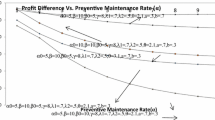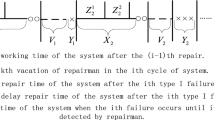Abstract
This paper deals with the reliability modelling and evaluation of a linear consecutive 2-out-of-4 system under online and offline preventive maintenance. The failure and repair time are assumed exponentially distributed. Through the transition diagrams, a system of first-order linear differential difference equations is obtained. Explicit expressions of system availability, mean time to failure busy period of repairman and profit function using probabilistic approach have been developed. Impacts of online preventive maintenance, offline preventive maintenance, and failure and repair rate on system availability, profit and mean time to failure have been investigated. The results of this paper will enhance the system performance and will be useful for timely execution of proper maintenance improvement, decision, planning and optimisation.
















Similar content being viewed by others
References
Adhikary DD, Bose GK, Bose D, Mitra S (2013) Maintenance class-based cost-effective preventive maintenance scheduling of coal-fired power plants. Int J Reliab Saf 7(4):358–371
Aggarwal AK, Kumar S, Singh V (2017) Mathematical modeling and reliability analysis of the serial processes in feeding system of a sugar plant. Int J Syst Assur Eng Manag 8(1):435–450
Ahmad R (2018) Reliability analysis comparison on punching tool sets due to different maintenance decisions: a case study from the pulp manufacturing industry. Int J Adv Manuf Technol 94(5–8):1969–1979
Ali A, Khaliq S, Ali Z (2018) Reliability estimation of s-out-of-k system for non-identical stress–strength components. Life Cycle Reliab Saf Eng 7(1):33–41
Barak MS, Sudesh N, Barak K (2018) Profit analysis of a two-unit cold standby system model operating under different weather conditions. Life Cycle Reliab Saf Eng 7(3):173–183
Barron Y, Frostig E, Levikson B (2006) Analysis of r out of n systems with several repairmen, exponential life times and phase type repair times: an algorithmic approach. Eur J Oper Res Algorithm Approach 169:202–225
Batun S, Azizoglu M (2009) Single machine scheduling with preventive maintenances. Int J Prod Res 47:1753–1771. https://doi.org/10.1080/00207540701636348
Bhardwaj RK, Malik SC (2010) MTSF and cost effectiveness of 2-out-of-3 cold standby system with probability of repair and inspection. Int J Eng Sci Technol 2(1):5882–5889
Bhardwj RK, Chander S (2007) Reliability and cost benefit analysis of 2-out-of-3 redundant system with general distribution of repair and waiting time, DIAS—technology review. Int J Bus IT 4(1):28–35
Chander S, Bhardwai RK (2009) Reliability and economic analysis of 2-out-of-3 redundant system with priority to repair. Afr J Maths Comp Sci 2(11):230–236
Chang C (2013) Optimum preventive maintenance policies for systems subject to random working times, replacement, and minimal repair. Comput Ind Eng 67:187–194
Eryilmaz S (2012) m-consecutive-k-out-of-n: F system with overlapping runs: signature-based reliability analysis. Int J Oper Res 15(1):64–73
Feng Q, Coit DW (2010) Reliability analysis for multiple dependent failure processes: an MEMS application. Int J Perform Eng 6(1):100–102
Goel LR, Sharma GC (1986) Gupta P (1986) Reliability analysis of a system with preventive maintenance, inspection and two types of repair. Microelectron Reliab 26(3):429–433
GölbAs O, Demirel N (2017) Risk-based reliability allocation methodology to set a maintenance priority among system components: a case study in Mining. Eksploatacja i niezawodnosc 19(2):191
Goyal N, Ram M, Amoli S, Suyal A (2017) Sensitivity analysis of a three-unit series system under k-out-of-n redundancy. Int J Qual Reliab Manag 34(6):770–784
Grall A, Berenguer C, Dieulle L (2002) A condition-based maintenance policy for stochastically deteriorating systems. Reliab Eng Syst Saf 76:469–489
Haggag MY (2009) Cost analysis of a system involving common cause failures and preventive maintenance. J Math Stat 5(4):305–310
Huang W, Askin RG (2003) Reliability analysis of electronic devices with multiple competing failure modes involving performance aging degradation. Qual Reliab Eng Int 19:241–254
Joseph VR, Yu IT (2006) Reliability improvement experiments with degradation data. IEEE Trans Reliab 55:149–157
Julanto A, Yun EWY, Yamamoto H (2016) Preventive maintenance policy for linear consecutive k-out-of-n: F system. J Oper Res Soc Jpn 59(4):334–346
Julien B, Barreau M, Gerville-Rache L, Gurin F, Schimmerling P (2014) Reliability assessment based on degradation measurements: how to compare some models? Reliab Eng Syst Saf 131:236–241
Kadyan MS (2013) Reliability and profit analysis of a single-unt system with preventive maintenance subject to maximum operation time. Eksploatacja i Niezawodnosc Maint Reliab 15(2):176–181
Kadyan MS, Promila Kumar J (2014) Reliability modeling of a single-unit system with arbitrary distribution subject to different weather condition. Int J Syst Assur Eng Manag 5(3):313–319. https://doi.org/10.1007/s13198-013-0168-3
Keedy E, Feng Q (2012) A physics-of-failure based reliability and maintenance modeling framework for stent deployment and operation. Reliab Eng Syst Saf 103:94–101
Khatab A, Nahas N, Nourelfath M (2009) Availbilty of k-out-of-n: G systems with non identical components subject to repair priorities. Reliab Eng Syst Saf 94:142–151
Kumar R, Kadyan MS (2018) Reliability modelling and study of failure mechanism of distillery plant using supplementary variable technique. Life Cycle Reliab Saf Eng 7(3):137–146
Kumar A, Ram M (2017) Effects of k-out-of-n: G/F and parallel redundancy in an industrial system through reliability approach. In: AIP conference proceedings, vol 1860, No. 1. AIP Publishing, p 020046
Kumar A, Saini M (2018) Comparison of reliability characteristics of two semi-Markov repairable systems under degradation and abnormal environment. Life Cycle Reliab Saf Eng 7(4):257–268
Kumar A, Saini M, Devi K (2018a) Stochastic modeling of non-identical redundant systems with priority, preventive maintenance, and Weibull failure and repair distributions. Life Cycle Reliab Saf Eng 7(2):61–70
Kumar R, Rajeevan AK, Shouri PV, Nair U (2018b) Markov modeling and reliability allocation in wind turbine for availability enhancement. Life Cycle Reliab Saf Eng 7(3):147–157
Lal AK, Kaur M, Lata S (2013) Behavioral study of piston manufacturing plant through stochastic models. J Ind Eng Int 9:24
Li Y, Yun MX (2011) Reliability analysis of a warm standby repairable system with priority in use. Appl Math Model 35:4295–4303. https://doi.org/10.1016/j.apm.2011.03.002
Lin J, Pulido J, Asplund M (2015) Reliability analysis for preventive maintenance based on classical and Bayesian semi-parametric degradation approaches using locomotive wheel-sets as a case study. Reliab Eng Syst Saf 134:143–156
Liu Y, Fan X (2016) Time-independent reliability analysis of bridge system based on mixed copula models. Math Probl Eng. https://doi.org/10.1155/2016/2720614
Liu Z, Ma X, Yang J, Zhao Y (2014) Reliability modeling for systems with multiple degradation processes using inverse Gaussian process and copulas mathematical problems in engineering. Math Probl Eng. 2014:1–10. https://doi.org/10.1155/2014/829597
Lu H, Kolarik WJ, Lu SS (2001) Real-time performance reliability prediction. IEEE Trans Reliab 50:353–357
Mahmoud MAW, Moshref ME (2010) On a two-unit cold standby system considering hardware, human error failures and preventive maintenance. Math Comput Model 51(5–6):736–745
Malik SC, Kumar A (2012) Reliability modelling of a computer system with priority to s/w replacement over h/w replacement subject to MOT and MRT. Int J Pure Appl Math 3(9):7191–7204
Mujahid SN, Abdur Rahim M (2010) Optimal preventive maintenance warranty policy for repairable products with periodically increasing failure rate. Int J Oper Res 9(2):227–240
Niwas R, Kadyan MS (2015) Kumar J (2015) Probabilistic analysis of two reliability models of a single-unit system with preventive maintenance beyond warranty and degradation. Eksploatacja i Niezawodnosc Maint Reliab 17(4):535–543. https://doi.org/10.17531/ein.2015.4.8
Nourelfath M, Fitouhi M, Machani M (2010) An integrated model for production and preventive maintenance planning in multi-state systems. IEEE Trans Reliab 59(3):496–506
Pan Z, Balakrishnan N (2011) Reliability modelling of degradation of products with multiple performance characteristics based on gamma processes. Reliab Eng Syst Saf 96:949–957
Pawan AG, Lal AK, Sharma AK, Singh J (2005) Numerical analysis of reliability and availability of the serial processes in butter oil processing plant. Int J Qual Reliab Manag 22:303–316
Peng H, Feng Q, Coit DW (2009) Simultaneous quality and reliability optimization for microengines subject to degradation. IEEE Trans Reliab 58:98–105
Ram M (2013) On system reliability approaches: a brief survey. Int J Syst Assur Eng Manag 4(2):101–117
Ram M, Kumar A (2014) Performance of a structure consisting a 2-out-of-3: F substructure under human failure. Arab J Sci Eng 39(11):8383–8394
Ram M, Kumar A (2015) Performability analysis of a system under 1-out-of-2: G scheme with perfect reworking. J Braz Soc Mech Sci Eng 37(3):1029–1038. https://doi.org/10.1007/s40430-014-0277-y
Shakuntla C, Lal AK, Bhatia SS, Singh J (2011) Reliability analysis of polytube industry using supplementary variable technique. Appl Math Comput 218:3981–3992
Shao J, Lamberson LR (1991) Modelling shared-load k-out-of-n : G systems. IEEE Trans Reliab. https://doi.org/10.1109/24.87129
Singh VV, Rawal DK, Ram M (2011) Study of reliability measures of a local area network via copula linguistics approach. Int J Qual Reliab 32(1):97–111
Song S, Coit DW, Feng Q, Peng H (2014) Reliability analysis for multi-component systems subject to multiple dependent competing failure processes. IEEE Trans Reliab 63(1):331–345
Taneja G, Goyal A, Singh D (2011) Reliability and cost benefit analysis of a system comprising one big unit and two small identical units with priority for operation/repair to big unit. Math Sci 5:234–248
Tang J, Chen C, Huang L (2018) Reliability assessment models for dependent competing failure processes considering correlations between random shocks and degradations. Qual Reliab Eng Int. https://doi.org/10.1002/qre.2390
Tsai YA (2004) A study of availability centred preventive maintenance for multicomponent systems. Reliab Eng Syst Saf 84:261–270
Uemura T, Dohi T, Kaio N (2010) Availability analysis of an intrusion tolerant distributed server system with preventive maintenance. IEEE Trans Reliab 59(1):18–29
Umarani D, Seyezhai R (2018) Reliability assessment of two-phase interleaved boost converter. Life Cycle Reliab Saf Eng 7(1):43–52
Uprety I (2012) Stochastic analysis of a reheating-furnace system subject to preventive maintenance and repair. Int J Oper Res 13(3):256–280
Waghmode LY, Patil RB (2016) Reliability analysis and life cycle cost optimization: a case study from Indian industry. Int J Qual Reliab Manag 33(3):414–429
Wang S (2013) Integrated model of production planning and imperfect preventive maintenance policy for single machine system. Int J Oper Res 18(2):140–156
Wu S, Zuo MJ (2010) Linear and nonlinear preventive maintenance models. IEEE Trans Reliab 59(1):242–249
Yusuf I (2016) Reliability modelling of a parallel system with a supporting device and two types of preventive maintenance. Int J Oper Res 25(3):269–287
Yusuf I, Hussaini N (2012) Evaluation Of reliability and availability characteristics of 2-out-of-3 standby system under a perfect repair condition. Am J Math Stat 2(5):114–119
Zhang Y, Ma Y, Ouyang L, Liu L (2018) A novel reliability model for multi-component systems subject to multiple dependent competing risks with degradation rate acceleration. Eksploatacja i Niezawodnosc Maint Reliab 20(4):579–589. https://doi.org/10.17531/ein.2018.4.9
Acknowledgements
The authors are grateful to the anonymous reviewers for their constructive comments which have helped to improve the manuscript.
Author information
Authors and Affiliations
Corresponding author
Additional information
Publisher's Note
Springer Nature remains neutral with regard to jurisdictional claims in published maps and institutional affiliations.
Rights and permissions
About this article
Cite this article
Yusuf, I., Yusuf, B. & Suleiman, K. Reliability assessment of a repairable system under online and offline preventive maintenance. Life Cycle Reliab Saf Eng 8, 391–406 (2019). https://doi.org/10.1007/s41872-019-00094-z
Received:
Accepted:
Published:
Issue Date:
DOI: https://doi.org/10.1007/s41872-019-00094-z




